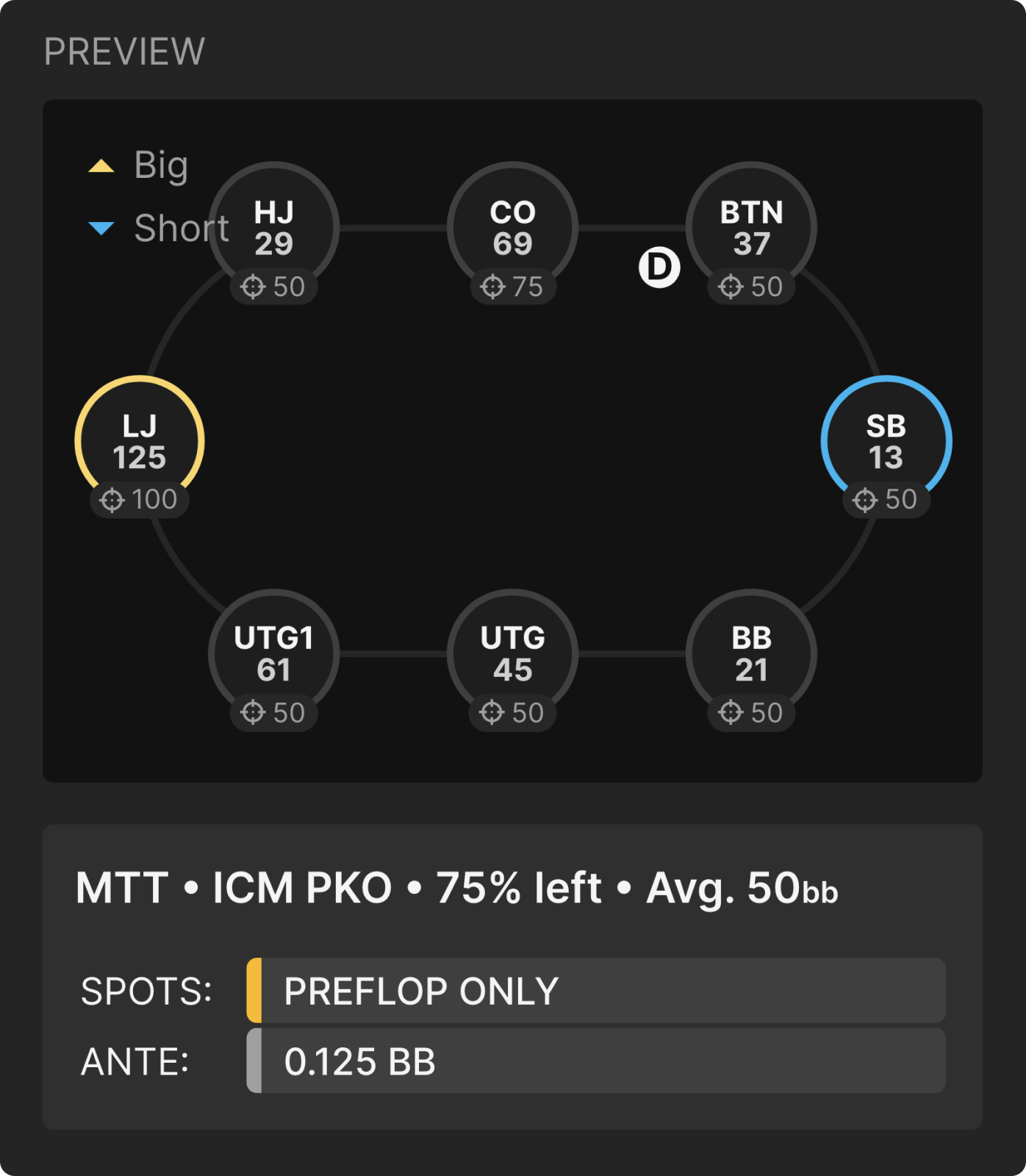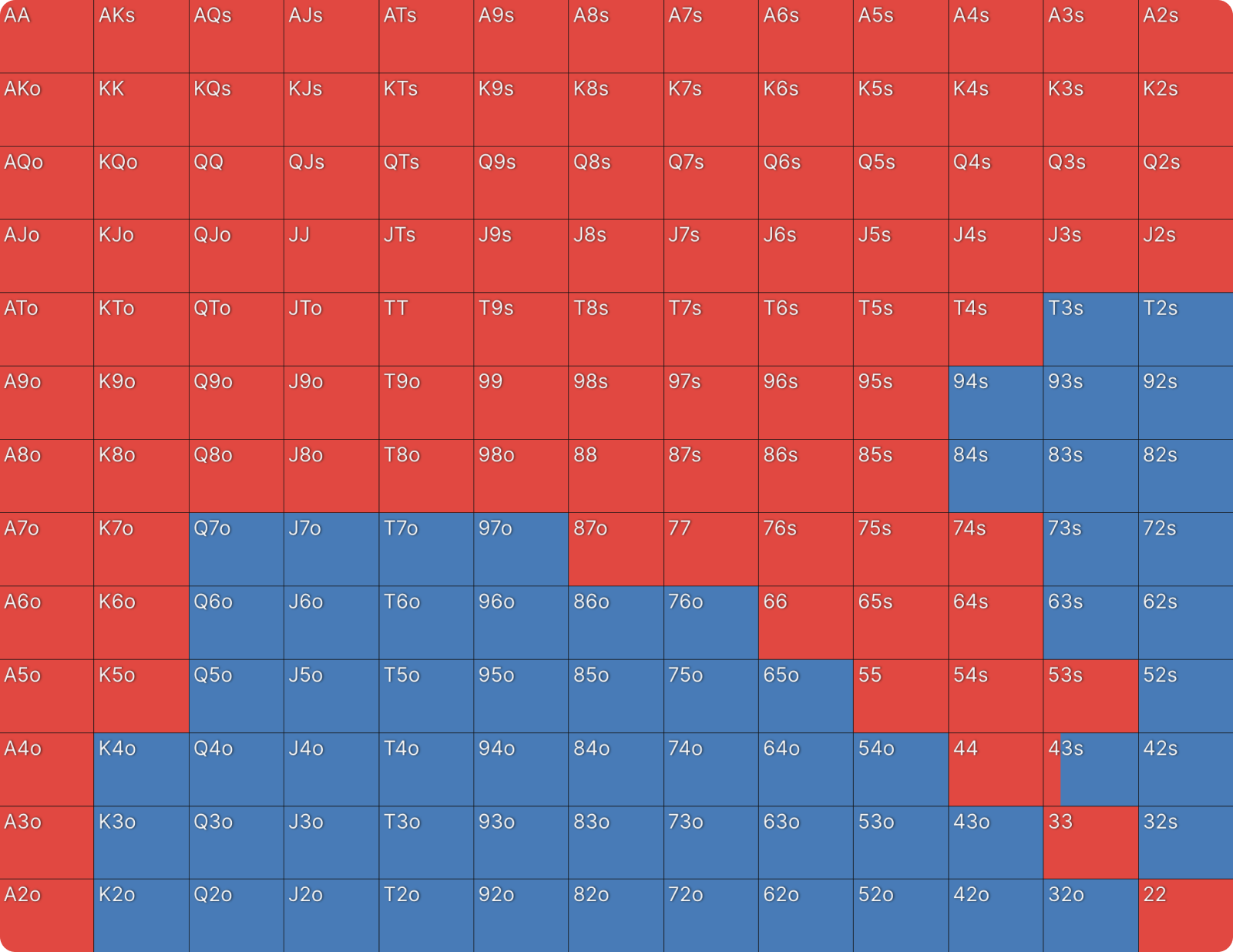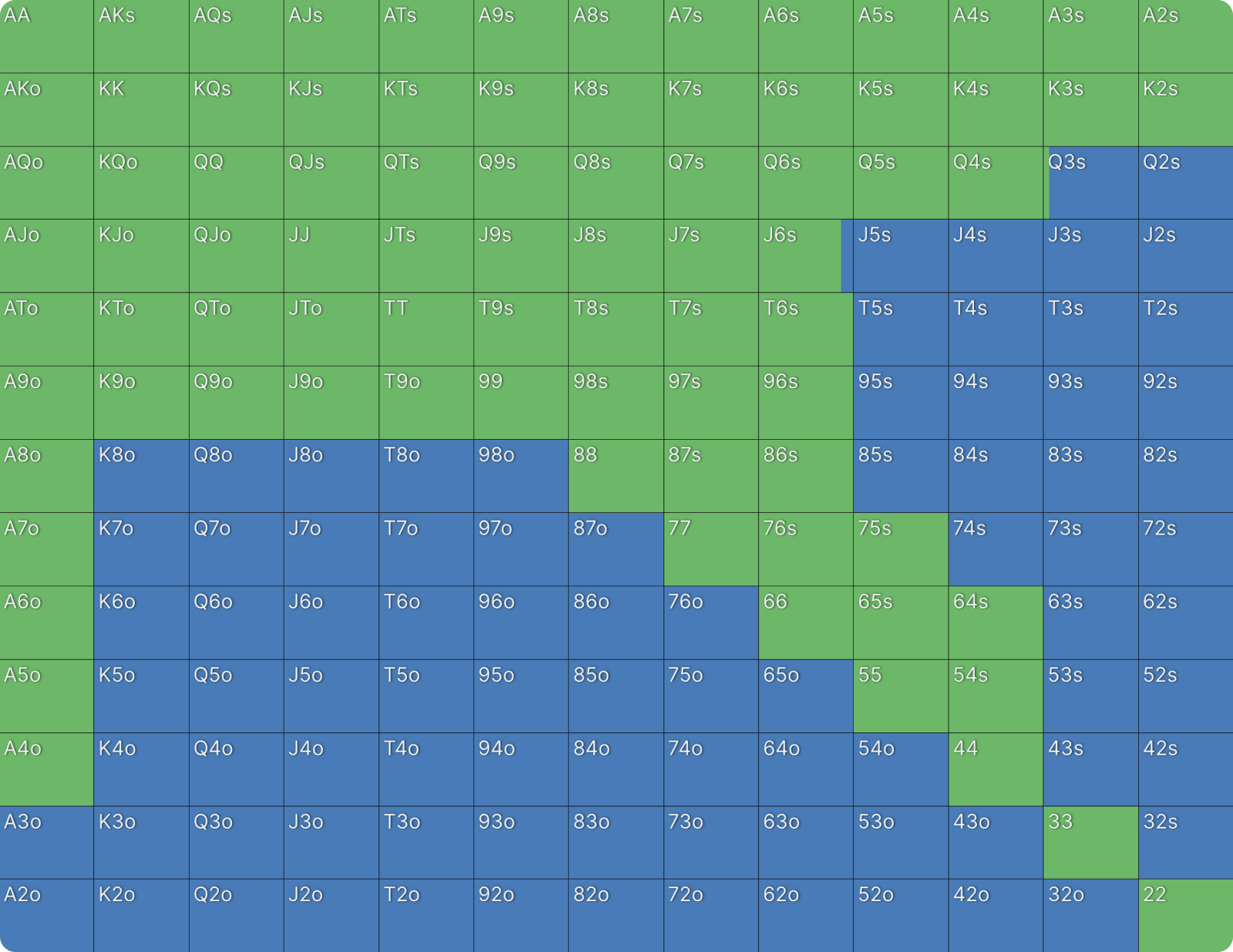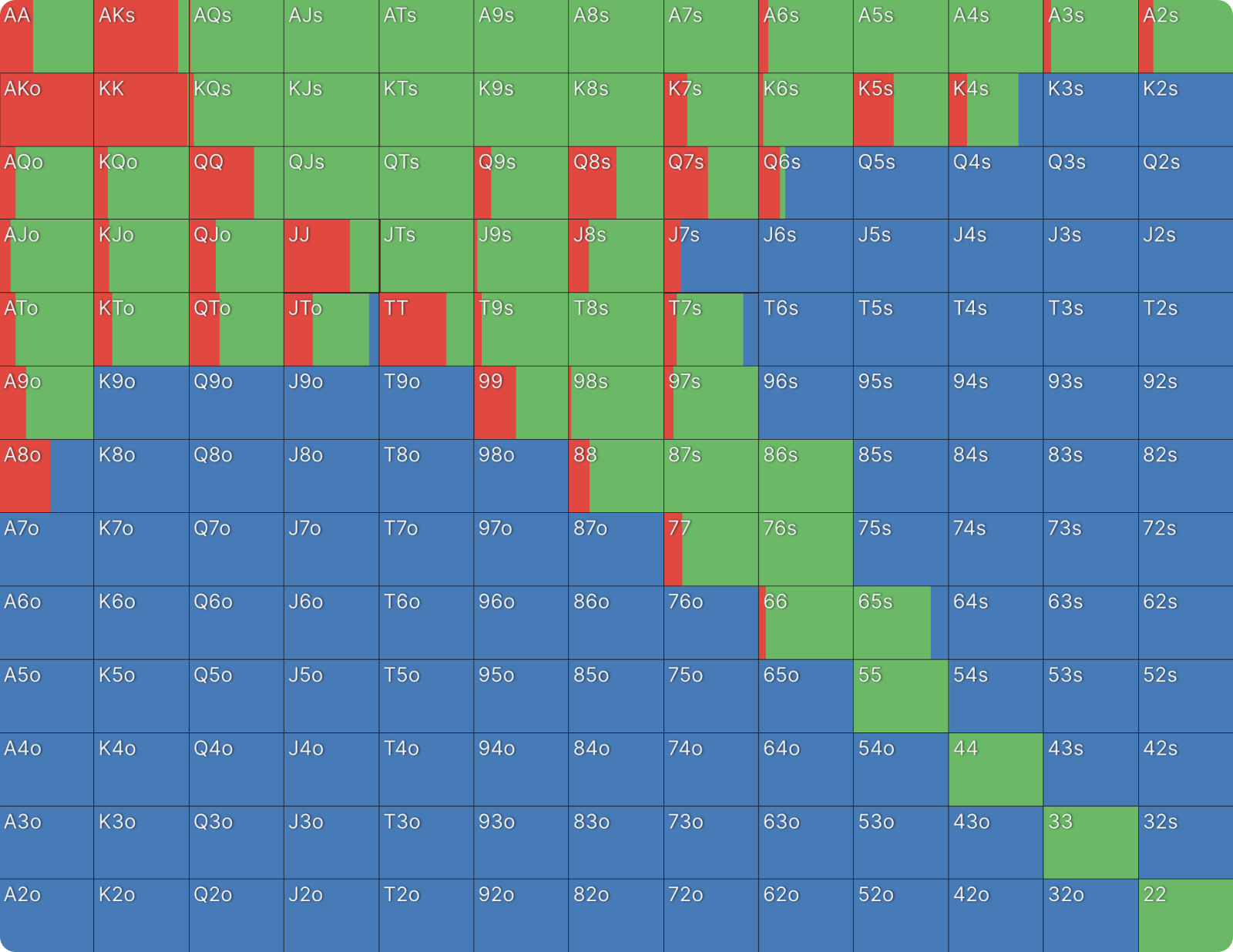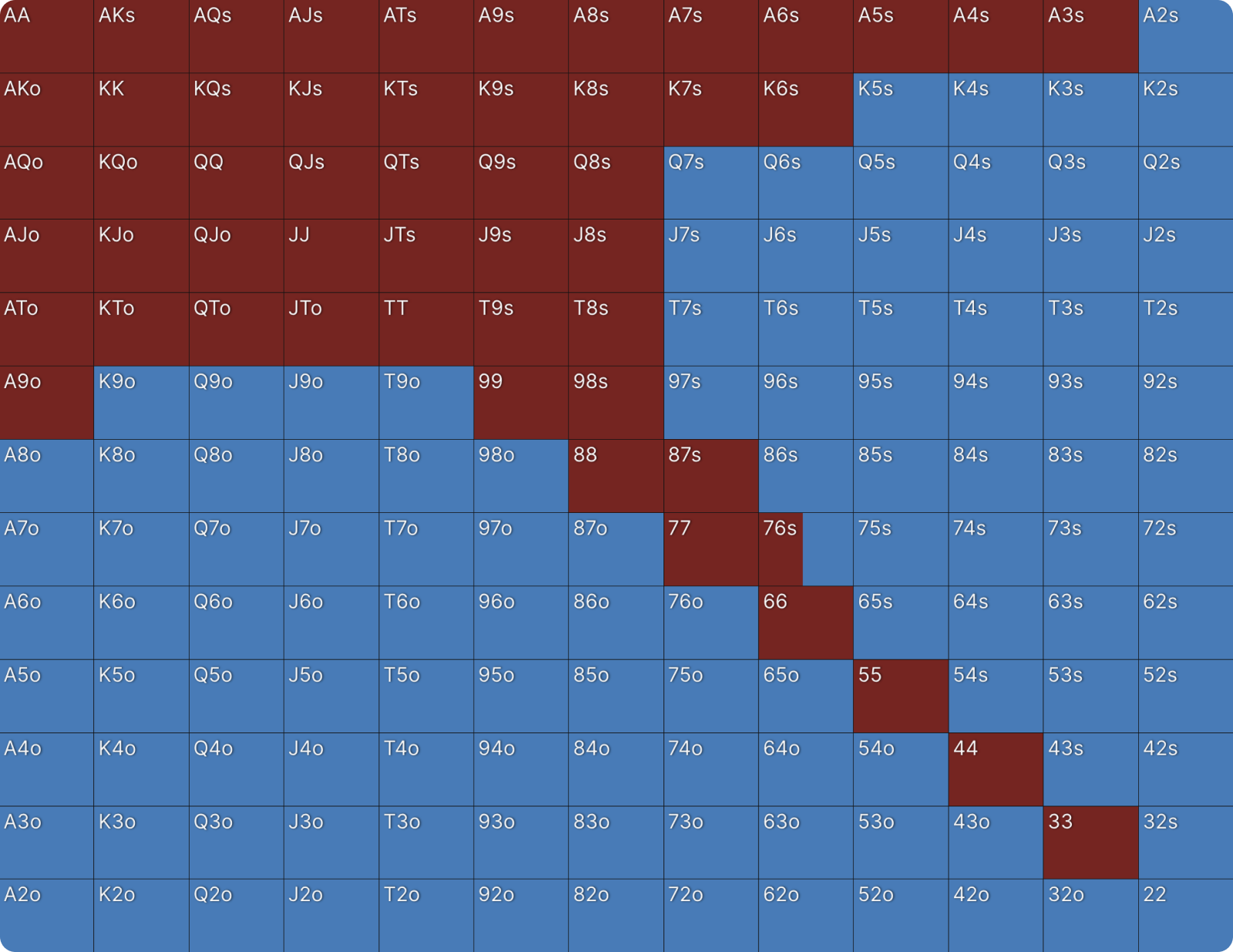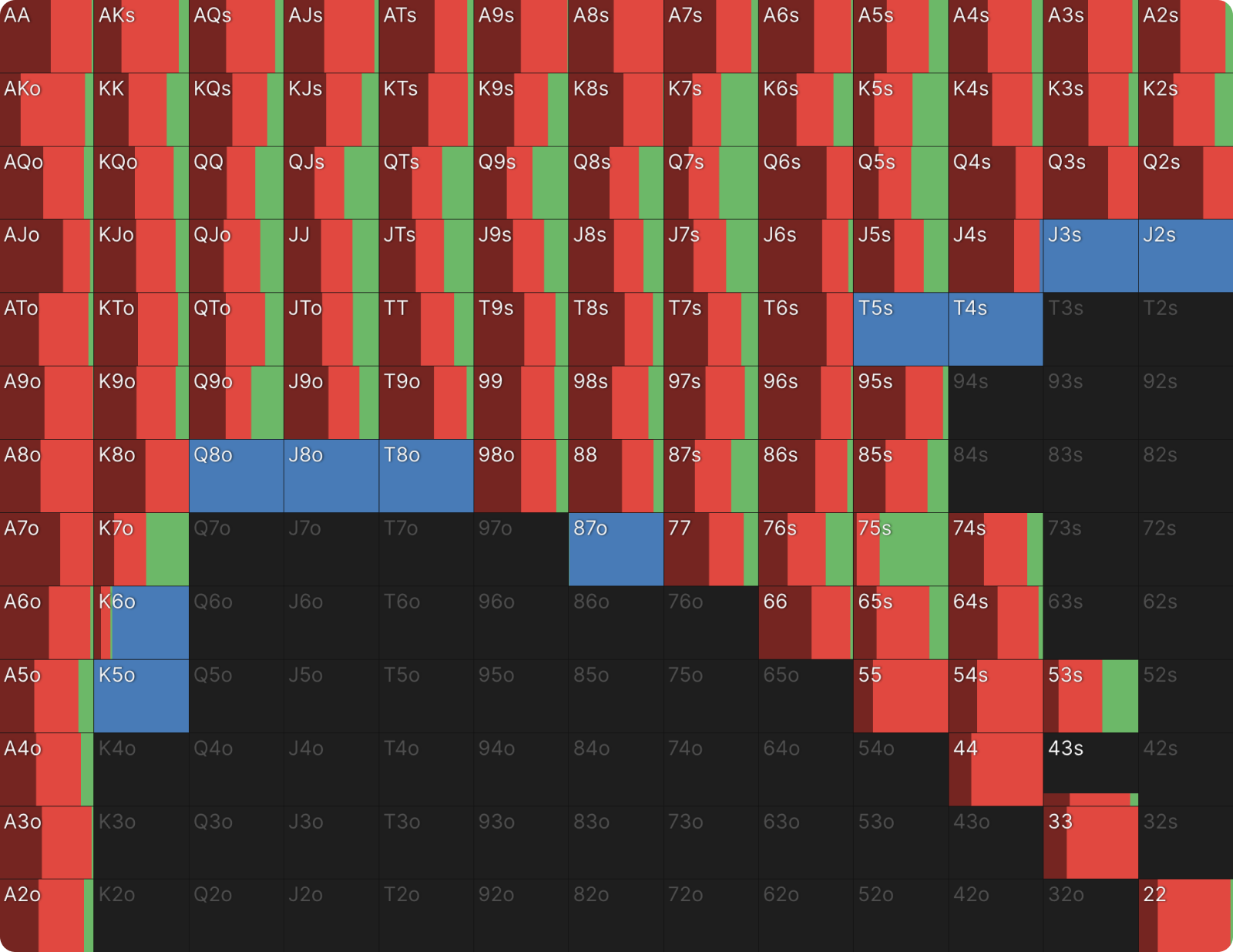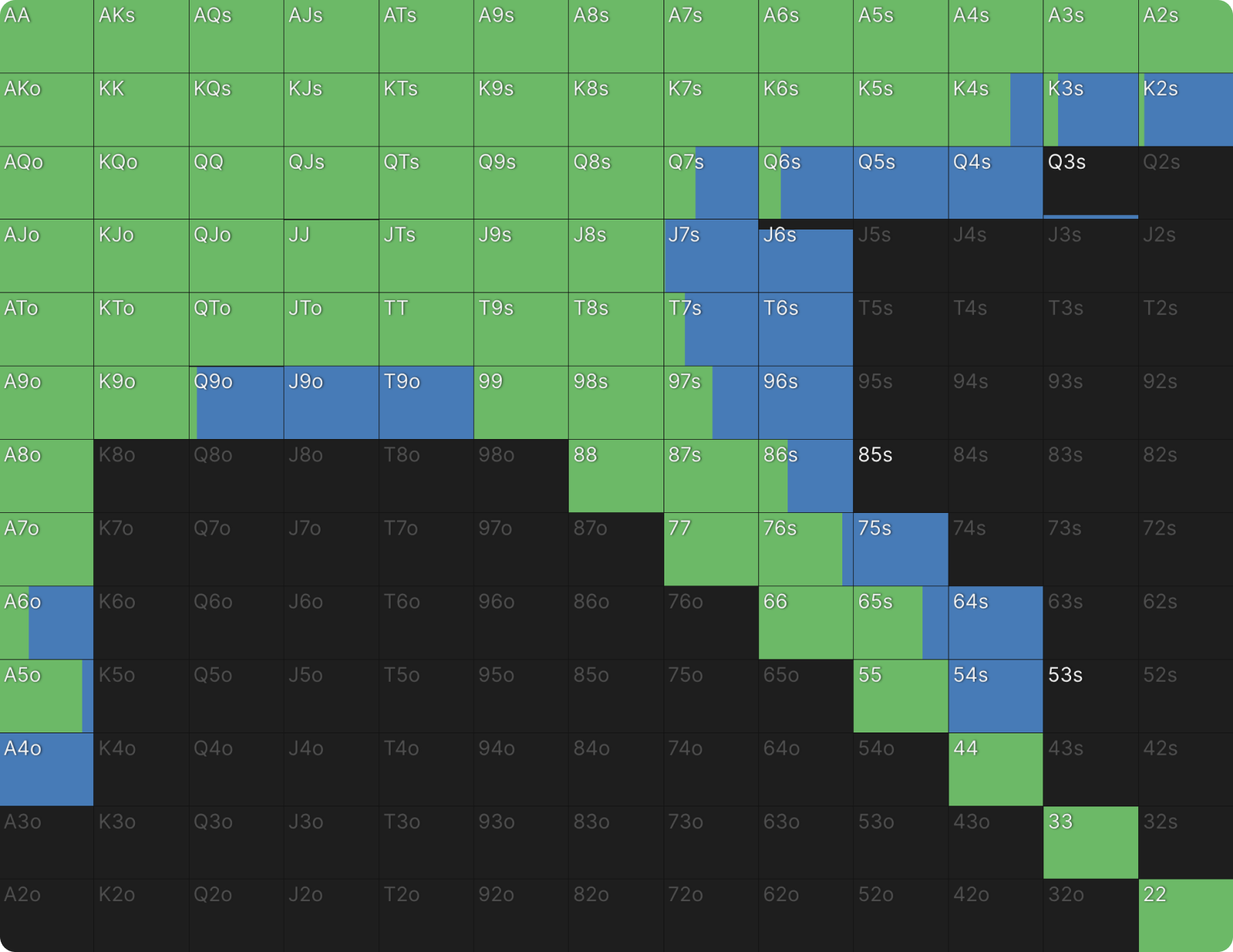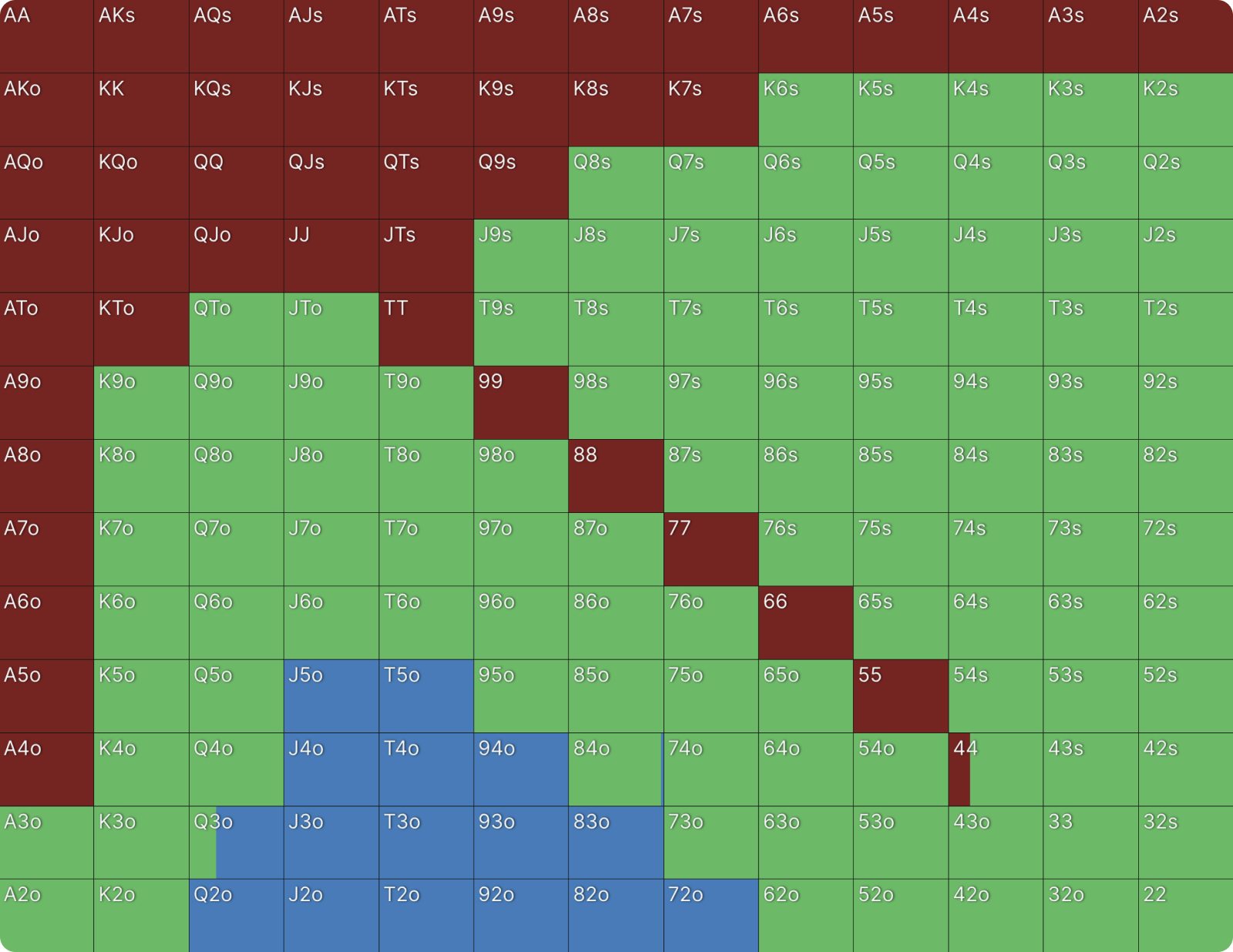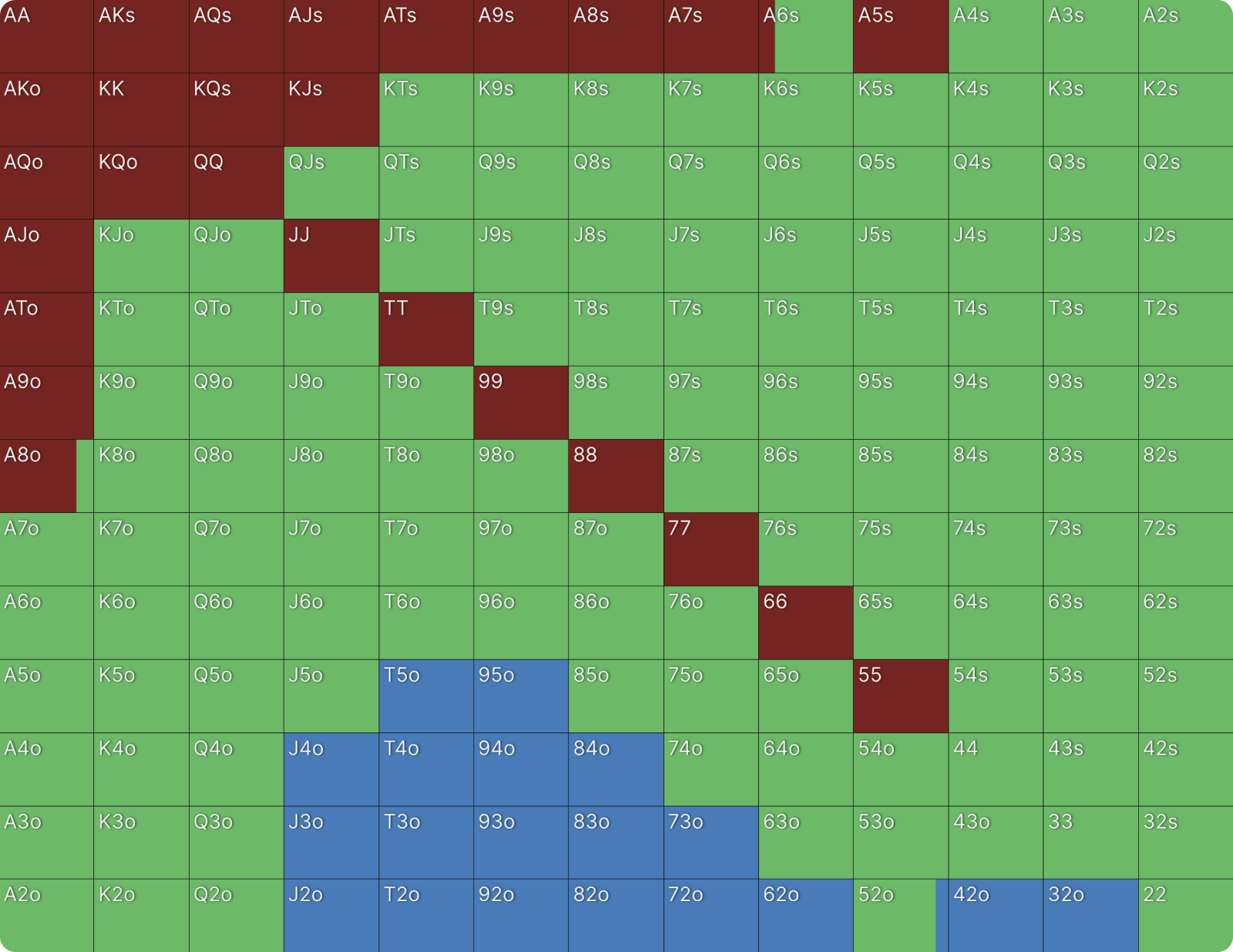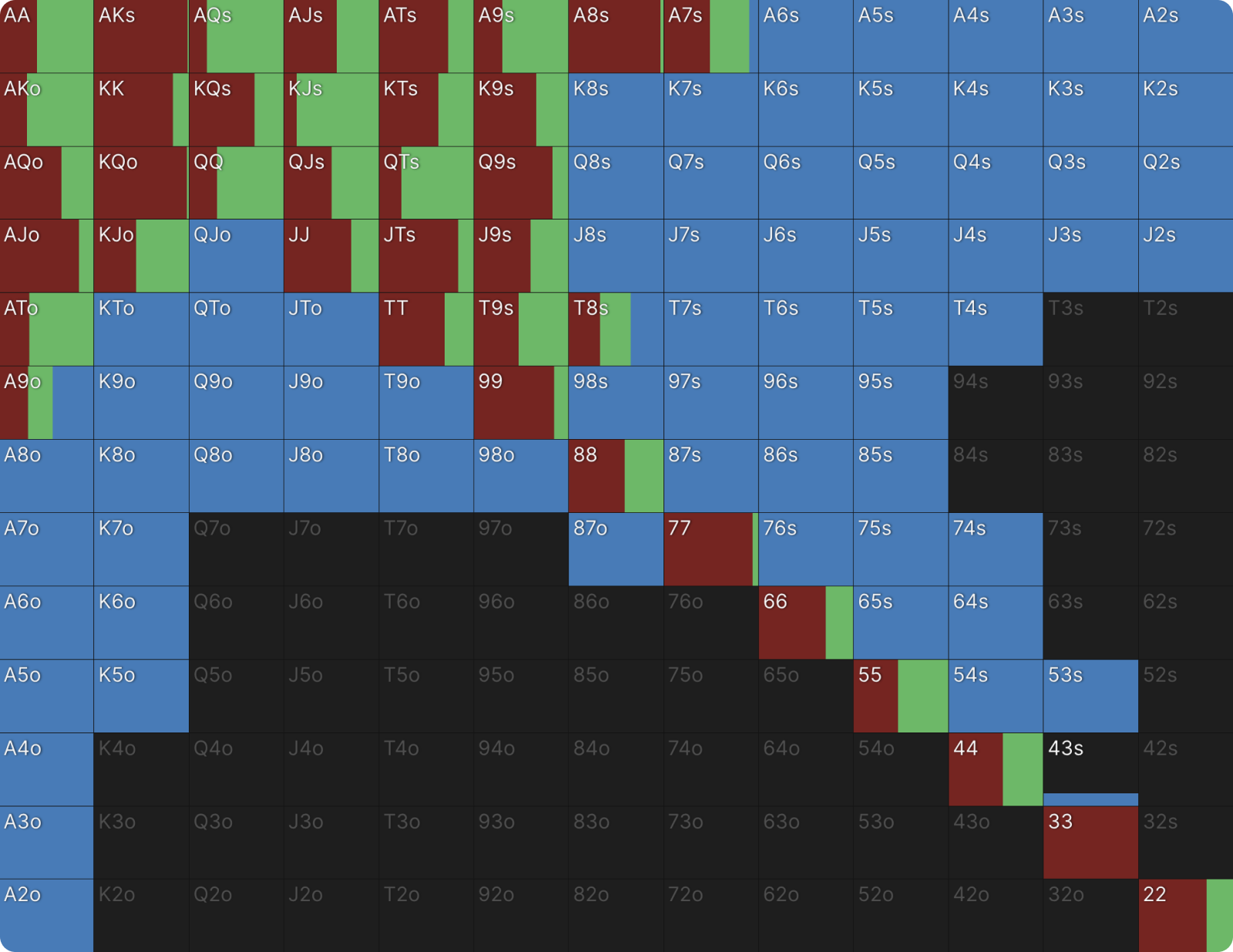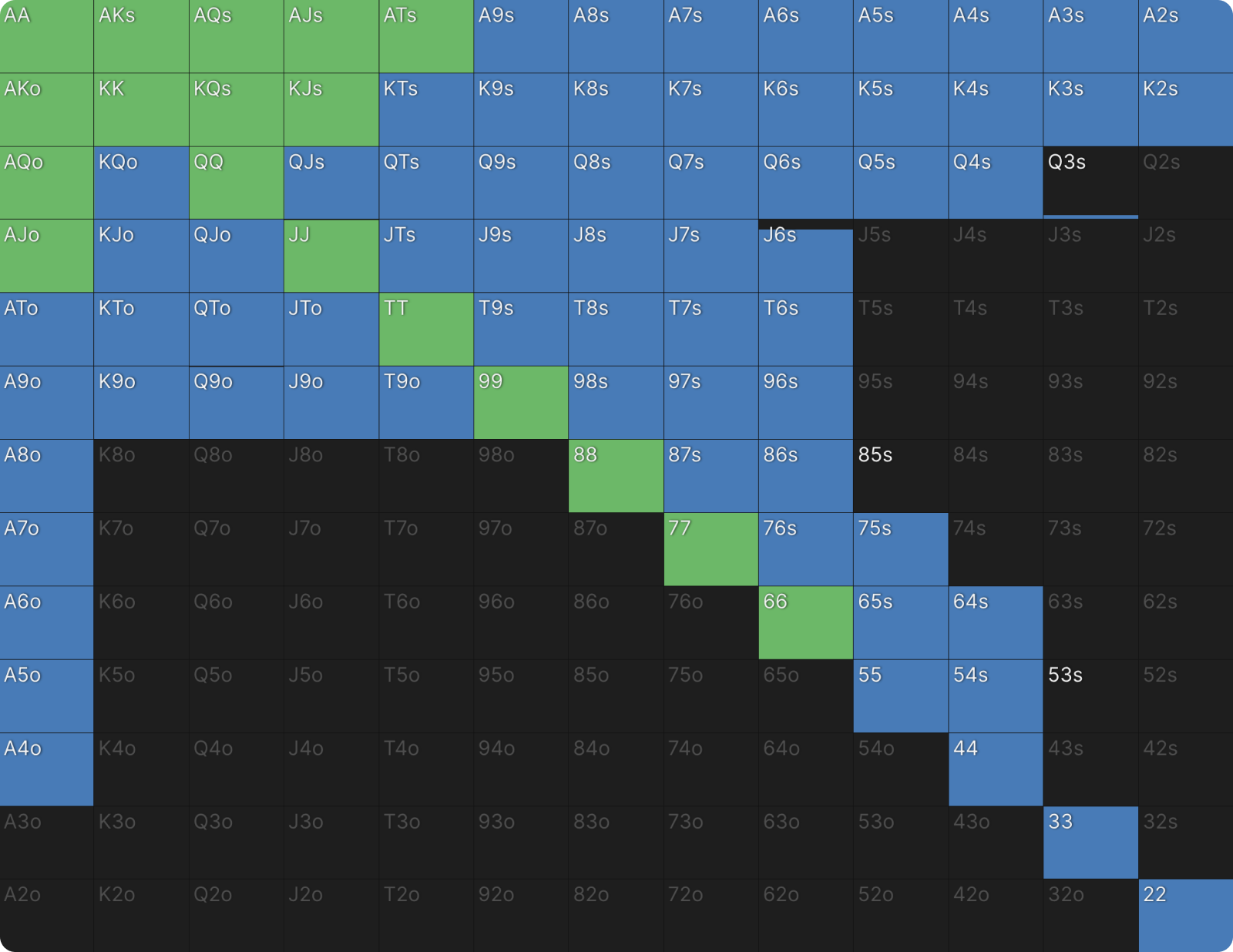When To Encourage Multiway Pots in PKOs
I was recently shown this fascinating PKO hand from the GTO Wizard PKO library. Somebody asked me whether it was correct because it involved a very surprising range.
75% of the field remains in this Progressive Knockout (PKO) TournamentProgressive Knockout Tournament (PKO)
In poker, a PKO (Progressive Knockout) tournament is a tournament format where a portion of the buy-in goes toward a bounty on each player’s head. In PKO tournaments, when a player eliminates another player, they typically receive a cash prize for half of the eliminated player’s bounty. The remaining half of the bounty is added to their own head for other players to try to claim. When two or more players win, in a split pot, the bounty is divided equally across all winners. Note, some sites such as Pokerstars run PKO tournaments where ⅔ or even the full prize pool are dedicated to bounty prizes.. Action folds to the CO with 69bb and a $75 bounty. The BTN has 37bb, the SB has 13bb, and the BB has 21bb. All of these players behind the CO have $50 bounties.
The CO opens with this range:
So far, so good. But this BTN response is unusual:
You are not looking at an error, nor have the color settings in GTO Wizard changed. The BTN continues 39% of the time, and when they do, they only call; they never raise. I have never seen a pure flatting range like this before, but I have seen very similar ranges in PKOs before. Once you understand the format well, this range will make sense.
The shape of the range looks like an opening range if BTN were first to act. It’s rare to see linearLinear
A range construction that consists of the top-down strongest hands. A linear range might contain nutted to medium-strength hands, or value to thin value. flatting ranges like this in any format.
It’s always helpful to compare PKO ranges to their nearest ChipEV equivalent. Here is the 35bb effective BTN response to a CO open:
The continuing range’s overall shape is similar, but it is much wider in the PKO. The BTN continues with 27.6% of hands here compared to 39% of hands in the PKO, which is not a great surprise. There is a significant 3-betting range in the non-PKO solution, however. All the big overpairs are 3-bet to some degree, as does AK. The value hands are accompanied by an assortment of bluff hands, giving us board coverage.
Pay Attention to Whom You Cover in PKOs
The answer to why the BTN only calls reveals perhaps the most important strategic adjustment in PKO tournaments. As discussed in our article on Table Management in PKOs, knowing who you cover is the most critical consideration in Progressive Knockout Tournaments.
How often you enter the pot and whether you open, raise, or call should be determined by how the players you cover may respond. This is all because of the bounty.
You should always be paying attention to whom you cover in PKOs. If you presently don’t cover many people, it can be correct to deviate from GTO and take on extra risk to cover more people in the future. If you do cover many people, as the chip leader for example, it can be correct to pass a slight edge to avoid losing your advantage. How often you enter the pot and whether you open, raise, or call should be determined by how the players you cover may respond. This is all because of the bounty and the potential to unlock it.
As we have discussed before, when you win a bounty, you win 4 types of equity:
- The ICM equity from the ‘regular payout’ portion of the prize pool
- The immediately realized equity for winning the opponent’s bounty
- The potential future equity of winning more bounties because you cover more people at the table
- The potential future equity of winning your own bounty when you win the whole tournament
Winning a bounty is so much more valuable than winning a big pot. Most of the time, winning the bounty is preferable to winning a pot several times larger with no bounty.
Particularly in the early stages, before ICM is a significant factor in PKOs, the bounties are worth a lot. In terms of immediately realized equity, they are usually worth at least 25% of your buy-in. This is demonstrated by the Bubble Factor in PKOs, which usually starts at less than 1, something you never see in regular MTTs.
With that in mind, why is the BTN flatting so much in this example?
Adjust for the Bounties You Can Win
The CO covers the BTN, so the BTN cannot win the CO’s $75 bounty this hand. The BTN does cover both the SB and the BB, however. The BTN can win both of these bounties, and they won’t even have to risk all their chips in the process.
It would be very nice to double up against the CO; that would put the BTN second in chips at the table. But there is still the chip leading LJ who covers them comfortably. The LJ should be playing very loose and aggressive at this table, making it tougher for whoever else has a big stack to win bounties. Instead of doubling up, the best outcome for the BTN would be to win one (or two) bounties!
Suppose the BTN 3-bets in this spot, the SB and the BB would be incentivized to fold a lot. However, when the BTN flat-calls, the blinds are getting a better price to continue. Indeed, look at the SB’s response to a BU flat-call:
Against a BTN 3-bet, the SB would fold 86.9% of the time, compared to only 72.8% folding versus a flat. The SB only has 13bb, so calling a shove is easy for most hands in the BTN’s range when you factor in the bounty, assuming everyone else folds.
SB Squeezes All-in
However, another crucial factor in this hand is that the BB covers the SB. The BB has the 2nd shortest stack at the table, so the SB is their only shot at a bounty right now. When the SB shoves, this is how the BB responds:
This is a very wide range to call a squeezeSqueeze
A preflop play whereby a player raises after one player has made an open-raise, and the second player has called that raise. The idea is to “squeeze” the caller out of the hand, thus increasing the dead money in the pot., and it showcases what we discussed in our article on multiway strategy in PKOs. Ranges get wider, not tighter, in multiway pots in Progressive Knockout Tournaments. This is because of the bounties, especially when there is a shot at multiple bounties. Also, don’t forget that the CO and BTN ranges were wide to begin with. The BB’s range here—mostly suited high cards—plays very well against three opponents. Notice hands like A8o and 22 fold, but all the suited high cards that can make straights, flushes, and good one pair hands go hunting for the bounty.
When the BB shoves as well, the CO proceeds as follows:
They put the BTN all-in with most of their range, only folding the really weak hands that don’t play so well multiway and calling with a very small portion of their range (there are no pure calls either, every hand that calls also puts the BTN all-in at some frequency). When they do put the BTN all-in, this is how the BTN responds:
The BTN calls 77.6% of their original flat-calling range. Notice that, once again, the shape of the range is geared towards hands that play well multiway against wide ranges, which is mostly suited broadway hands that can often hold up if they make one pair, but have outs if they run into a monster.
If you are new to PKOs, this calling range might be hard to understand. This is one of the aspects of PKOs that make it quite a bonkers format. It is correct to set up situations where you find yourself calling off multiway for your tournament life with hands like Q9s. PKOs are not for the faint-hearted.
SB Overcalls
Let’s rewind the hand two steps and see what happens when the SB overcalls instead of shoves. This is BB‘s response:
They continue with almost 100% of hands. Their raising range is almost identical to that in the last example.
If this is what happens, BTN will have a very profitable situation. They now find themselves in a postflop spot with the positional advantage against four very wide ranges with two bounties they can potentially win, and it would only take a bit more than a pot-sized bet to put them in play.
SB Fold
Even when SB folds, the BB continues this way:
The BB continues almost as often, even though they cannot win a bounty. This is because the CO and BTN’s ranges are so wide that it becomes very profitable for them to continue, especially when they close the action.
What happens when SB folds and BB shoves? This is CO’s strategy:
The CO still continues fairly frequently, but much tighter now that there are only two—rather than three—bounties they can win. When CO shoves, the BTN responds like this:
Likewise, the BTN folds much more in this example. The prospect of risking their tournament life for only a single bounty as a reward has shifted them towards folding most of the time.
When the CO calls instead of shoves, it is just a formality, the BTN shoves the exact same range, and then the CO calls.
Conclusion
The most important consideration in PKOs, particularly at the start, is how many players you cover. Always be aware in every hand how many players you can win a bounty from and how many could win one from you. Also, pay attention to where they are at the table. A player you cover seated next to you is worth a lot more than a player you cover four positions away.
In this hand example, there was a perfect storm that led to the exclusively flatting range of the BTN. It was early in the MTT, so bounties were worth the most in terms of equity. The LJ with the chip lead had gotten out of the way, meaning the CO became the de facto chip leader. The CO with the next biggest stack was in a late position, so they could open a very wide range. Our Hero had the BTN, meaning they always have position postflop. They covered the blinds but not the CO. Just flatting increases the likelihood of the SB entering the pot and eventually putting their bounty into play. Three reasons to flat instead of raise. The SB was short stacked, so they had a natural squeezing stack when the BTN flats, and their bounty would be put immediately into play. Finally, the SB was the only bounty that the BB, who was also short, could win.
Take out one or two of these variables out of the equation and the BTN probably does not flat their whole range.
Multiway pots are very profitable in PKOs when you cover multiple players, even if you are covered yourself. The common response in online games is to see a lot of isolation raises from the covering players, trying to win a single bounty without any resistance. The big takeaway here is perhaps that passive play can be preferable to aggressive play in PKOs when it can encourage opponents whom you cover and can win a bounty from to enter the pot behind you, not isolating to thin the field.
Author
Barry Carter
Barry Carter has been a poker writer for 16 years. He is the co-author of six poker books, including The Mental Game of Poker, Endgame Poker Strategy: The ICM Book, and GTO Poker Simplified.

